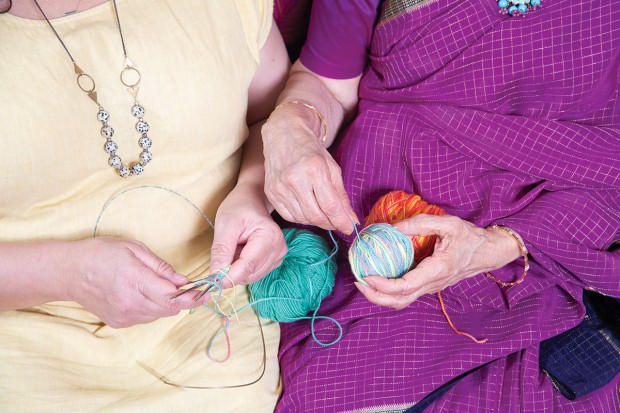Stitches of Love
Honoring a grandmother’s legacy

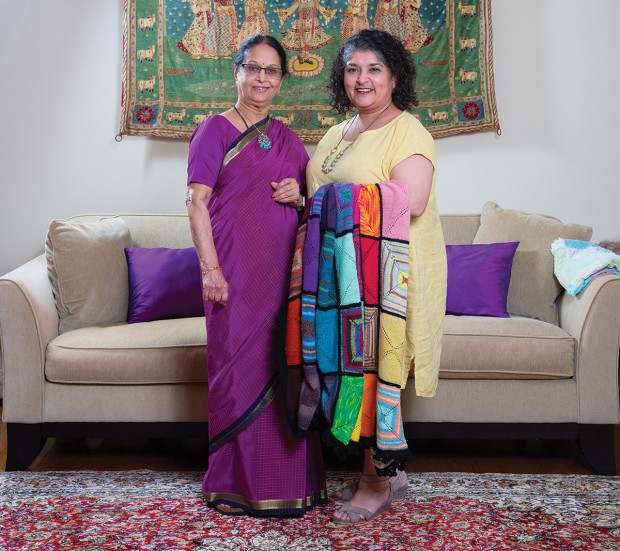
CREATORS OF CRAFT Keerthi McIntosh (right) holds one of nine afghans she created with her mother Geetha Rau (left) and aunts – many in India – as part of a knit-along honoring her grandmother Indira Boray, who beautified her world through textile creations. (Photo: lawellphoto.com)
Keerthi McIntosh, a sparkplug of enthusiasm in curly black hair, has hands that won’t quit. They sew and embroider, crochet, quilt, and knit. Nimble fingers spring textiles to life, like seedlings to harvest.
“There are very few textile crafts I don’t embrace,” says the New Orleans artisan who is visiting her mother, Geetha Rau, this day at her West University home to discuss their afghan project, a far-flung knit-along that had spry fingers putting yarn to needle 9,425 miles away, in the land of mountains and metropolises, tigers and temples.
India. Her parents’ homeland.
Draped across the sofa in Geetha’s living room is a 6-by 8-square afghan in rows of vibrant hues with a black crocheted border that resembles tassels. It’s one of nine identical afghans that Keerthi knitted with her mom and six aunts over several years. A blanket of love honoring her long-deceased maternal grandmother, Indira Boray.
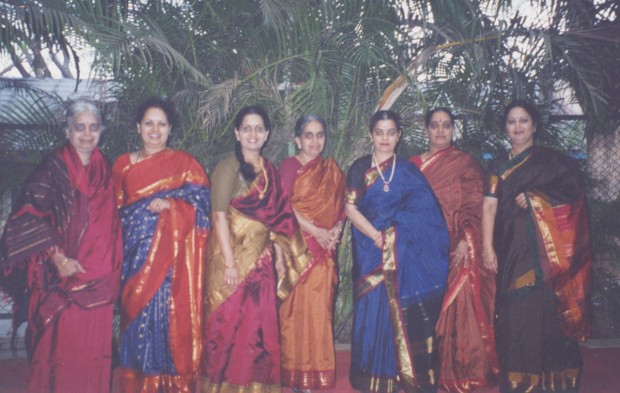
TALENT ON TAP These seven sisters carry on their mother Indira Boray’s textile skills. From left: Vasantha Swamy, of Bangalore, India; Nalini Nadig, of Sugar Land; Pratima Hariprasad, of Bangalore; Uma Nath, of Bangalore; Jayashree Rao, of Somerset, NJ; Chandrika Rao, of Bangalore; and Geetha Rau, of West University.
“Our family has this code of beautifying your life,” Keerthi explains. “It came from my grandmother. She was into creative arts and into beautifying your space. I felt this connection because I sew, I knit, I tat. My grandmother was a beautiful tatter. It’s a form of handmade lace with knots, kind of like macrame, but much finer. If there was a way to beautify something, she would do that. She taught all her children to do that.”
Yes, Keerthi didn’t fall far from that proverbial tree. The first of her family born in the United States, she’s an avid textile creator, a talent learned in large part from her mother, who taught Keerthi and her older sister Aarthi Jain – these days a busy physician, living two streets down from their parents – to sew early on. Knitting was taught, too, and then other fun stuff with fabrics, needle, and thread.
“Of all the grandchildren, I’m kind of the one who kept up the most with the textile crafts,” Keerthi says. “My sister sews some, mostly if she has to. But it’s an ongoing thing with me. I just finished my house and made all the window treatments. I make quilts for my nieces and nephews. I make home décor. I’m super active with it.”
Keerthi’s brain got to percolating back in 2009 after reading about a knit-along, where a group of people work together on the same project.
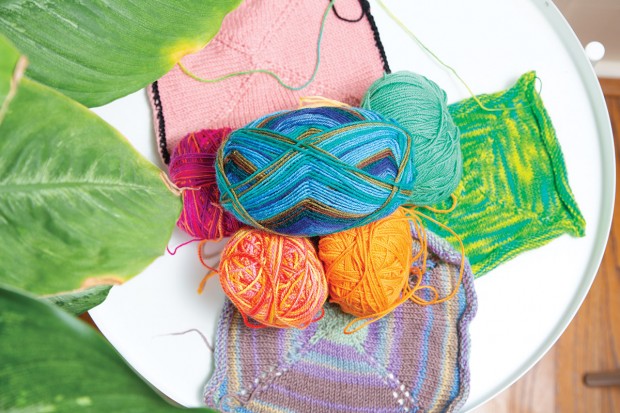
Remnants of crochet squares and yarn from the family’s knit-along adorn a table. (Photo: lawellphoto.com)
As a surprise, she sent knitting kits to her mom and six aunts, four of whom live in India, requesting they make 54 squares each for a total of nine identical afghans so they could each have one and auction another for charity. Said charity to be determined.
“I sent everyone a box with enough yarn to make nine squares of each color. From the get-go, it was by design to have nine afghans so every participant could have one. To have something you made, but they did, too. And we love the idea of charity and passing along and respecting my grandmother. Honoring her.”
Surely with this family’s creative history, her aunts and mom would be game, she thought. What better way to show off the textile dexterity in their genes? The kit included yarn, two sets of circular knitting needles, a set of double-pointed knitting needles, stitch markers, a crochet hook, a pattern and instructions, and a sweet letter asking that they honor Indira by participating.
Aunts Vasantha Swamy, Uma Nath, Chandrika Rao, and Pratima Hariprasad received theirs at their respective homes in India; Nalina Nadig’s went to her Sugar Land home; Jayashree Rao, who recently moved to New Jersey, received the surprise package, too, at her Houston abode.
Not one of them said no.
Busy fingers started flying, yarn to needle.
“What a way to connect!” exclaims Keerthi, setting the scene for their inspiration:
Imagine Geetha and her siblings decades ago, a total of 12, once you add five brothers. And visualize their home in India, preening in textiles of every sort – vibrant blankets, silk embroideries, delicate lacework crafted by hand. And there’s a colorful sand painting just outside their front door, ritualistically brushed away after its fleeting moments in time.
And in the center of this happy scene is Indira, wife to a physics professor, whose hands concocted all this beauty, despite limited resources. Weaving memories for her family, one stitch at a time. Passing onto her children those seeds of creativity.
“Yes, my mother made our home elegant. It was subtle and beautiful,” recalls Geetha, flashing a smile.

INDIRA’S INFLUENCE Geetha Rau and daughter Keerthi McIntosh, the brainchild of the afghan knit-along, visited their family of co-knitters in India in December 2018 while there for a wedding. From left: Keerthi, Geetha, and Geetha’s sisters Vasantha Swamy, Nalini Nadig, Jayashree Rao, Uma Nath, and Keerthi’s cousin, Dhanu Nagaraj, who hosted the gathering.
The project, kicked off in 2009, saw the last afghan completed in 2021. “There was a time I thought we’d never get it done!” exclaims Keerthi, who received all the knitted squares back within a few years. Then the tedious work of “blocking” began, manipulating each slightly wonky piece back into a perfect square.
“You have to wash them and when it’s wet you stretch it out, making sure the dimensions are as they’re supposed to be,” she explains. “I have a special corkboard where I’d pin them to dry out and then it would become a square.”
She recalls a scene at her New Orleans home in 2012 when assembling the first afghan for delivery to her eldest aunt, Vasantha, in India, in time for her birthday.
Aunts Nalini and Jayashree came to Keerthi’s home with her mother for the weekend, Indian music playing, fingers crocheting squares, each to the other. “We were telling lots of stories about wedding plannings in the past because my Aunt Jayashree’s son was getting married and she was going to India to go wedding shopping,” recalls Keerthi. “It was so fun, everyone telling stories and reconnecting in a different way. Kind of like a quilting bee. Your hands are busy, and you’re relaxed, just chatting away.
“I love the way my aunts really got into it,” continues the retired geophysicist who visited them in Bengaluru, India while on work assignment with Shell. “I wasn’t just this niece they hadn’t seen in 25 years. We had this connection through the afghans. I think the most interesting thing about the connection was that the aunts who were a little bit more removed from their creative side got in touch with it again. Particularly my mom’s oldest sister who is a brilliant and talented woman. She really got the knitting bug bad!”
“Doing this together was an opportunity for some to rekindle their interest in this type of textile work,” agrees Geetha. “Some of them, you get busy with family, and you don’t always get to do these things regularly. I think it was special because of that.”
Geetha’s home reflects family talent with many of her own creations donning the walls. Keerthi points to a hand-embroidered piece of a woman in the front hallway that her mother did as a young adult, newly engaged. And another embroidery by the stairs created in silk thread from Japan.
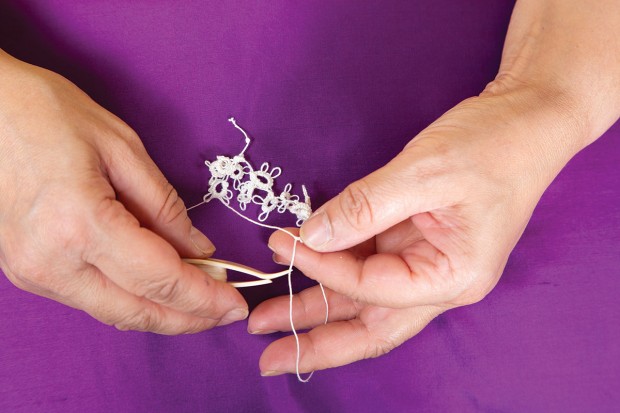
Keerthi shows how to make a form of handmade lace with knots, known as tatting. (Photo: lawellphoto.com)
Round the corner to Geetha’s dining room and there’s a glass cabinet of dolls. Dolls that Geetha made. No, not just their clothing. Their bodies of porcelain were handcrafted by Geetha, their faces detailed by her hand.
She’s making a crazy quilt now from bits and pieces of materials, blouses, and saris. She flips through a bounty of colorful, patterned silks that she’s crafted into fun squares. She’s itching to apply all sorts of embroidery and textile brilliance to the blocks that will one day come together as a blanket of remnants, memories.
Yes, an artistic panache runs through this family’s veins. Little wonder. Indira, the woman they so revere, had some inspiration of her own. Her mother, a charitable sort, well-connected in the community with a husband as a judge, was a talent with her hands, too. She made socks for WWI soldiers. Indira did the same with eldest daughter Vasantha, sewing socks for soldiers during WWII, and making socks and scarves for soldiers headed north during the latter part of the Indian Independence Movement.
“Our family does not have idle hands,” quips Keerthi, holding a framed tatted piece that her grandmother made years ago.
“It’s just who we are,” says the textile artist, who envisions another family project in the future, this time with her nieces and mom. “But let’s give them time to grow. My youngest niece is only 13.” The family’s younger generations have the artistic knack. Her son, 27, is an artist, acrylics on canvas his medium.
India, its rich history and culture, is the background that courses through this family’s blood. Ornate temples, garments of every hue. A country of symbolic colors. Reds, purples, oranges. Blues the color of sky and water. Majestic yellow-golds like sunsets.
Even its dump trucks are painted in beautiful flowers and embellishments, says Keerthi. “Indians will embellish any surface. It can be a moving surface.”
“We are definitely not afraid of color,” states Geetha, draped in a purple sari, its thread cut from pure gold. “In India, we live our religion. Hinduism is a way of life, a guide to love. And part of that is very artistic.”
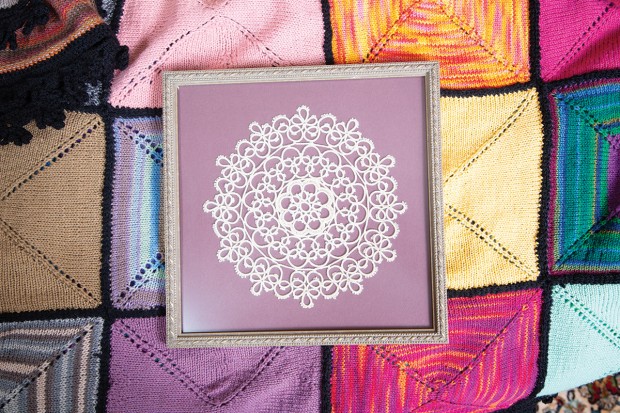
An intricate tatted piece made by Geetha’s mother Indira Boray is a treasured memento. (Photo: lawellphoto.com)
In 1963, Geetha boarded a plane for the first time with Keerthi’s sister Aarthi, just months old, making her way to New York and eventually meeting up with husband, Rama, who came to the U.S. in 1962, a year after they married. The couple lived on campus at New Mexico State in Las Cruces where he was a student. It was there that Keerthi was born.
Rama’s career blossomed. With a Ph.D. in electrical engineering, he created well logging tools for the oil industry. The family settled into their life in the U.S. seamlessly, helping brothers and sisters come here, too.
“My parents were the first to immigrate here. That opportunity was reserved for the absolute brightest across all of India,” Keerthi explains. “In order to have a seat here at a university, you had to be brilliant. You were the smartest that India had. That’s my dad. He saw that window and came.”
Keerthi has fond memories of visiting fabric stores with her sister during their later childhood years in League City. “They were petite in size and didn’t want to wear kiddie clothes to high school. So, they started sewing,” says Geetha.
Keerthi also recalls a more recent excursion, a 2019 trip to Minneapolis with her parents. They went to a yarn store. “It was 3,000 square feet of yarn,” Keerthi says, eyes dancing. “Mom and I were in bliss. My poor dad. He was a good sport. He didn’t complain at all. He just sat in a chair and played sudoku the whole time.”
Some passions are just part of you, tied to your soul, say this mother-daughter team, who treasure their afghans from the project. A picture of her finished afghan is Keerthi’s phone screensaver. It’s draped like a throw in her sewing room at home, eye candy that’s enjoyed, but seldom used. “Because I never get cold.”
Geetha’s is on her den sofa. She wraps it about her when a tad chilled, feeling the warmth of family in its fibers. “I feel like all my sisters are with me,” she says. “That makes me happy.”
Want more buzz like this? Sign up for our Morning Buzz emails.
To leave a comment, please log in or create an account with The Buzz Magazines, Disqus, Facebook, or Twitter. Or you may post as a guest.


